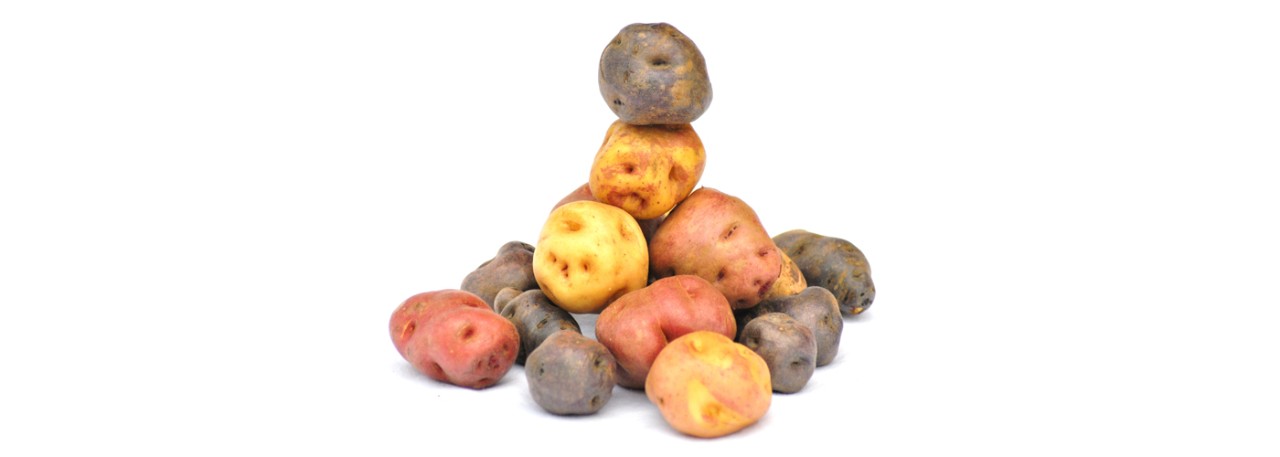.png.transform/rendition-xs/image_image%20(1).png)
Papas Antiguas de Canarias PDO
Potato tubers of varieties known in the Canary Islands as antiguas, also known as locales, tradicionales, de color and/or de la tierra (local, traditional, colored and/or from the land), grown in the Canary Islands from seed obtained in the production area and belonging to the species Solanum tuberosum subspecies Andigena, Solanum tuberosum subspecies Tuberosum and the triploid defined as Solanum chaucha, all introduced into the Canary Islands prior to the 20th century.
Tasting notes
The color of the flesh ranges from dark yellow to bright egg yolk yellow, becoming a deeper color when cooked, with very attractive anthocyanin rings. It has fresh, smooth and light aromas ranging from millet (maize) to chestnut and including butter. After cooking, the texture is typically non-grainy, and may be either floury, creamy and buttery or creamy, firm and not very floury. The flavor is reminiscent of roasted cereals and autumn nuts.
Other notes
Papas Antiguas de Canarias have the following distinctive features:
- Chemical and physical properties: protein content of more than 1.5 % weight/weight of dry matter, dry-matter content 21-30 % in some locations. This gives them a floury appearance when cooked. One of the special features of the product is its small size, which may vary from 1.5 cm to 8 cm.
- Morphological: The skin color ranges from deep blackish purple through pink and orange to brown. The tuber is a rounded shape with more or less deep eyes.
Production / Processing method
Preparing the land and sowing the seeds: Preparation of the land consists basically of aerating the soil by turning it over to a depth of between 15 cm and 20 cm / 5.9 in and 7.8 in. This work is normally done between December and February.
Tillage: A maximum of two plowings are done. The first plowing is deep and done before planting, with the aim of improving rainwater retention. The second plowing is done close to the sowing period.
The potatoes are placed in the bottom of the furrow at a distance of between 20cm and 30cm apart.
Earthing up: When the young shoots reach 10cm to 15cm in height they are earthed up by piling up the soil around the stems of the plant.
Harvesting and transport: Manual or mechanical harvesting takes place when the tuber has reached commercial maturity, a physiological stage indicated by the yellowing of the aerial parts of the plant, the fall of the foliage and the ageing of the tuber. Harvest time runs from May to August, depending on when sowing was done.
The harvested potatoes are transported in properly prepared and clearly labeled containers.
Preparation, handling and packaging of potatoes protected by the PDO may not, under any circumstances, be carried out on the same production line used for other non-protected potatoes.
The protected potatoes are sold in new, clean packaging, made from a suitable material to keep the product fresh. This packaging is mechanically sealed or sewn.
Geography / Relief and climate
Nowadays, many local growers in the Canary Islands still follow the same practices and traditional farming methods for growing the same varieties of primitive tubers that first arrived on the islands from America. Studies carried out on the islands show that these crops from America have adapted to the Canary Islands climate and environmental conditions and that today they possess a set of unique and very distinctive features.
The area defined as the growing area of Papas Antiguas de Canarias is a privileged haven with a very distinctive geographical personality, standing at less than 1,200 meters above sea level and in the area known as the medianías. The climate in this area climate is characterized by the cooler conditions at higher altitude, trade winds and the influence of the Canary islands cold sea current together with occasional blasts of wind from the African continent. The medianías are a uniquely important aspect of the landscape on the islands. The land has been slowly and painstakingly worked by the inhabitants, who for centuries have had to struggle against obstacles to the development of agriculture posed by the steep slopes, the absence of soil, the scarcity of water and strong winds, using all the techniques available to them.
The Canary Islands are volcanic mountains that were pushed up from the bed of the Atlantic Ocean, reaching considerable heights. This makes the island terrain extremely steep, with huge height gains experienced in only a few kilometers of travel.
On the steepest slopes of the islands, Papas Antiguas de Canarias are grown on so-called terraces, which are areas of flat land arranged in stepped fashion along the mountainsides. In places where the slopes are less steep, coinciding with the warmer areas, the crop is also grown in gavias or bebederos (small plots of land where rainwater accumulates). In this case, the crops are covered with jable, or volcanic sand, to prevent water evaporating, contributing a landscape of incalculable environmental value to the production areas.
Regulatory Council
La Papa Bonita, Cosecheros de Papas Antiguas de Canarias con DOP
C/Camino Real, 84. Local: Crta. a La Corona, 54
38414 Los Realejos - Icod el Alto - Tenerife
Canary Islands
T: (+34) 607 432 379
papabonita@gmail.com
www.papasantiguasdecanarias.com
Sources:
- Spanish Ministry of Agriculture
- Regulatory Council, PDO Papas Antiguas de Canarias
The flavor is reminiscent of roasted cereals and autumn nuts.


- /content/dam/en/icex-foodswines/images/products/fruits---vegetables/papas-antiguas-de-canarias-pdo/Papas%20Antiguas%20de%20Canarias%20PDO%20carr1.jpg
- /content/dam/en/icex-foodswines/images/products/fruits---vegetables/papas-antiguas-de-canarias-pdo/Papas%20Antiguas%20de%20Canarias%20PDO%20carr2.jpg

Santa Cruz de Tenerife (Canary Islands)
